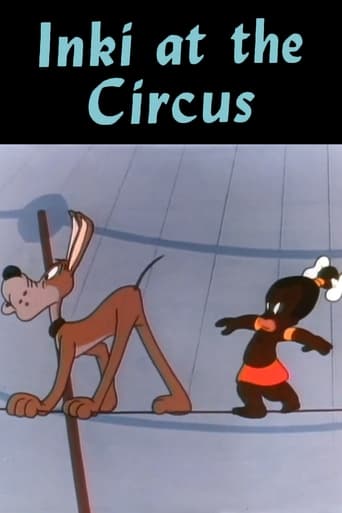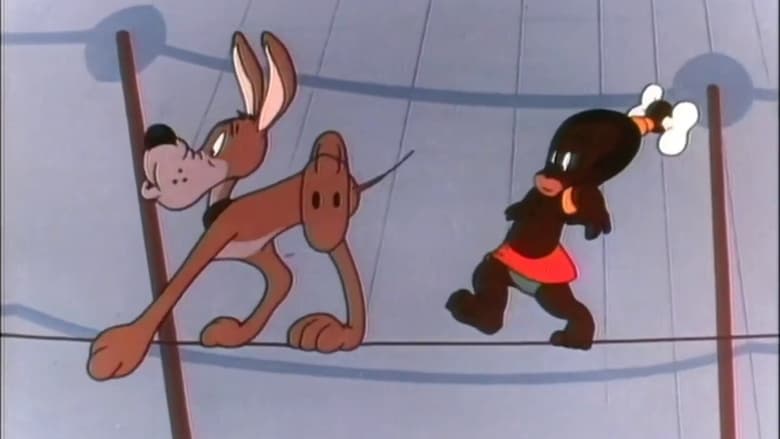

Inki at the Circus (1947)
Sitting dejected in a circus cage, billed as an African "wildman," Inki becomes the target of two dogs, both of them after the bone in his topknot. But luckily for Inki, the mysterious minah bird, syncopated hop and all, has also been captured and sent to the same circus.
Watch Trailer
Cast


Reviews
Best movie of this year hands down!
Pretty Good
A story that's too fascinating to pass by...
This is a gorgeous movie made by a gorgeous spirit.
Love animation, it was a big part of my life as a child, particularly Disney, Looney Tunes, Hanna Barbera and Tom and Jerry, and still love it whether it's film, television or cartoons. Actually appreciate it more even through young adults eyes, thanks to a broader knowledge.Chuck Jones is one of the greatest geniuses in animation history, or at least to me and many others, but 'Inki at the Circus' while still a watchable effort and one of the better Inki cartoons is not one of the best representations of him by any stretch. Once his style was properly found, when his cartoons became much funnier, wittier, more inventively animated and iconic characters introduced and made household names, Jones did go on to much better things. 'Inki at the Circus' having said that is an interesting look at him in his relatively early days.Although Inki is kind of cute and the interaction with the animals is amusing, people are not going to take kindly to the unappealing visual design of the character or the less than flattering stereotypical behaviour. Just to say though, there are far more offensive cartoons and characters about. 'Inki at the Circus' is more mildly amusing rather than laugh-a-minute or among the funniest cartoons around, and there could have been a little more variety in the gags.Story-wise, 'Inki at the Circus' is likable and lively in pace but it is pretty predictable and occasionally does try too hard to be cute.However, the rest of the animation is very good. It's beautifully drawn, very detailed and the colours are vibrant, complete with some great expressions for particularly the lion and shots.The music score is typically lushly and cleverly orchestrated, with lively and energetic rhythms, it's also beautifully synchronised with the action and gestures/expressions and even enhances the impact. There are great use of sound effects.'Inki at the Circus' is amiable and amusing enough, the timing is lively and the animals add a good deal. The dogs provide good fun to the proceedings. The best character is the Minah bird, namely for the perfectly synchronised movement and hopping to Mendelssohn's Hebrides Overture cleverly slowed down.Overall, nice and watchable but unexceptional. Doesn't see a genius of his craft at his best or on top form. 6/10 Bethany Cox
Probably the only place where you can easily find the Inki cartoons is on YouTube, given that most people would rather not show such images of Africans (when I was really young, I found "Little Lion Hunter" on a video cassette and even made a copy of it, but I don't remember which cassette it was). In this case, Inki is in a circus, billed as an African wild man; that's the kind of talk that I would expect from white Americans of the 1940s. Anyway, two dogs start trying to yank the bone out of his hair (one might interpret this as a representation of how the colonial powers sought to carve up Africa: they all wanted it for themselves, and never gave any thought to letting the indigenous people have their own land). But, sure enough, the silent-but-aggressive Minah bird has also come to the circus...and he's looking for a fight.I guess that as long as we understand what these cartoons portray, it's easier to accept them. Worth seeing.
This was a strange cartoon. It was obviously produced in an era when cultural commentary in films was considerably different from our days of political correctness. One reviewer said that Inki was a Hottentot. That comment intrigued me simply because I did not know what a Hottentot was. This cartoon character would be described today as an African-American child about three years old. His hair is adorned with a large white soup bone, and this bone is depicted as an object of desire for the two dogs in the piece. The cast of characters is rounded out with a strange bird who apparently possesses incredible strength. He arrives on the scene locked inside a steel safe, and with no apparent effort, smashes the door to the ground. The plot in this cartoon is virtually nonexistent. The dogs are chasing the little kid to get the bone and whenever they succeed, they promptly bury it. Naturally, the bone and the kid pop back up, and the chase begins anew. The bird more or less wanders around with no apparent purpose other than to look and act weird which he does with aplomb. The cartoon ends when the bone has been captured, and in order to find out who captures the bone, you'll have to see the cartoon. We don't want to spoil the suspense for you. Frankly, you can find better things to do with your time than to watch this.
Chuck Jones' Inki cartoons are rarely seen these days, because Inki is a small, stereotyped Hottentot with a bone in his hair, and we have come to see such images as racist and demeaning. Here, on exhibit in a circus and deviled by two dogs, one of whom would be developed into the high-pressure Charlie Dog of half a dozen cartoons, Inki is pursued and bedeviled -- and pursues and bedevils the dogs.But Inki, although the protagonist in these movies, is not the key character. The real star is probably the greatest of the Warner Brothers characters, a black mynah bird who has the best entrances in the business -- here he bursts out of a heavy safe -- and who walks, hunched over, through the cartoons with a stuttering, hopping step, underscored by Sibelius to a jazz beat. And whenever the mynah bird appears, so does chaos, because he's getting where he's going no matter what you do. The mynah is the trickster, even more than Bugs Bunny's take on Rabbit. In some ways he is a precursor on the Roadrunner, but much purer and funnier.It is a pity that he was always paired with Inki, because this makes him obscure -- the only other time I have seen him appear is in a meaningless turn in one of the Tweety-Sylvester mysteries that the Cartoon Network ran about the turn of the millennium. But these movies do turn up occasionally, if maddeningly infrequently. If you have a chance to see one, don't miss it.

